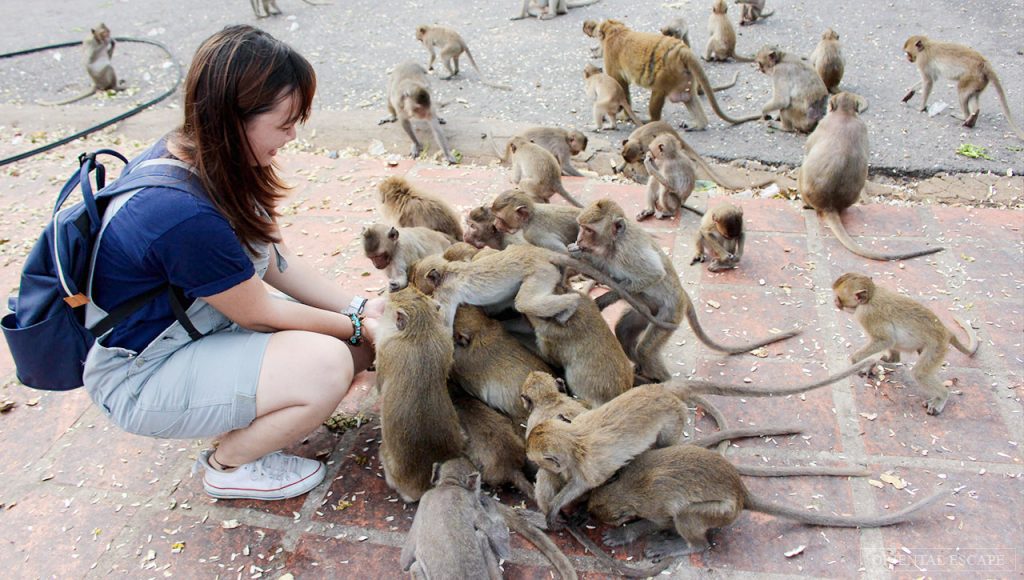On a road near an ancient temple in Lop Buri, three rival gangs of monkeys competed for favourite food at the province’s landmark, Phra Prang Sam Yot, a thirteenth century temple, is famous for its monkey population.
Three monkey gangs from surrounding neighborhoods clashed on the roadway, impeding traffic. According to onlookers, someone had previously brought the monkeys’ favourite foods, such as sweetened fermented milk and ice pops, and positioned them on the opposite side of the road.
That was the start of the fight. The long-tailed macaques rushed wildly, resulting in a brief skirmish. The war was over once the food was consumed.
The issue of monkey brawls has long been a source of contention in Mueang Lopburi Municipality, and local officials have been working to find a solution. However, the issue remains unresolved since locals and tourists frequently feed the monkeys incorrectly, generating tensions among them.
Monkeys are protected animals, and the Department of National Parks, Wildlife, and Plant Conservation is responsible for their care and management. Municipal authorities have no jurisdiction to catch or prosecute them.
When disagreements emerge, however, both provincial and municipal authorities are held accountable.
Monkeys brawling is prevalent in Lopburi; for example, in 2021, hundreds of monkeys rushed the streets of Lop Buri in a big fight, impeding traffic at a busy intersection.
It was another clash in what the Thai media refers to as a “monkey war” between two opposing groups of monkeys: street monkeys and temple monkeys.
Hundreds of monkeys from competing “gangs” brawled in the streets of Lop Buri near the popular tourist site Phra Prang Sam Yod. The mediaeval shrine has earned the moniker “monkey temple” since it is home to a big colony of macaque monkeys. Every year, the province hosts a festival in which the monkeys at the temple are served a buffet of fruits and vegetables.
Lop Buri province, located around 150 km north of Bangkok, is well-known for its massive macaque monkey population, which local officials have attempted to suppress by mass sterilization.
While one gang of monkeys takes over the shrine grounds, another… or probably more… take over the streets. They’ve been known to steal food and water bottles from passers-by. One monkey was even captured sneaking into a woman’s home and taking food from her refrigerator just last week.
It’s unknown why the two monkey gangs got into a fight. Some suggested in the past that monkeys from one group may have encroached on the “territory” of the other, maybe due to a lack of food.
Others speculated that the heat had made the monkeys more aggressive.
 Lopburi is a central Thai region notable for its population of monkeys. Lopburi itself is home to hundreds, if not thousands, of monkeys that freely walk the streets and temples, making it a one-of-a-kind and popular tourist destination.
Lopburi is a central Thai region notable for its population of monkeys. Lopburi itself is home to hundreds, if not thousands, of monkeys that freely walk the streets and temples, making it a one-of-a-kind and popular tourist destination.
Long-tailed macaques, also known as crab-eating macaques, predominate in Lopburi. They have become an important component of local culture and are protected by the government. Monkeys are revered as sacred animals and are linked to the Hindu deity Hanuman, who is frequently represented as a monkey.
Visitors to Lopburi can observe the monkeys’ amusing and occasionally mischievous behaviour. They can be seen climbing buildings, running through streets, and interacting with each other and locals. Even an annual Monkey Buffet Festival is held in the city, where a massive feast is prepared for the monkeys to enjoy.
While the monkeys are normally harmless, using caution when dealing with them is advised. They can be opportunistic and will steal food or personal items if left alone.
To avoid any undesired encounters, keep a safe distance, avoid feeding them unless told by local guides, and safeguard your possessions.
Overall, Lopburi’s monkey population lends a distinct and endearing part to the city’s identity, attracting tourists from all over the world who want to get up close and personal with these intriguing creatures.


 Lopburi is a central Thai region notable for its population of monkeys. Lopburi itself is home to hundreds, if not thousands, of monkeys that freely walk the streets and temples, making it a one-of-a-kind and popular tourist destination.
Lopburi is a central Thai region notable for its population of monkeys. Lopburi itself is home to hundreds, if not thousands, of monkeys that freely walk the streets and temples, making it a one-of-a-kind and popular tourist destination.
